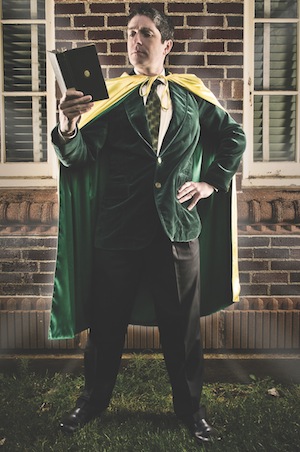Good news for students and scholars who take their comics seriously: Ben Saunders (left), associate professor of English, has championed the launch of a new minor in comic and cartoon studies.
Believed to be the first of its kind, the minor will create a structure for the exploration of comics, cartoons, graphic novels and more through a literary lens.
 Superheroes, in particular, are Saunders’ special interest. Two years ago, he curated an exhibit at the Jordan Schnitzer Museum of Art called Faster Than a Speeding Bullet: The Art of the Superhero and organized a companion conference.
Superheroes, in particular, are Saunders’ special interest. Two years ago, he curated an exhibit at the Jordan Schnitzer Museum of Art called Faster Than a Speeding Bullet: The Art of the Superhero and organized a companion conference.
His latest book, Do The Gods Wear Capes?: Spirituality, Fantasy, and Superheroes, further reveals his secret identity as a defender of the superhero’s place in the realm of scholarly inquiry.
In the U.S., comics have evolved as a visual form of cultural expression over the last several decades—beginning with the rise of the comic book in the 1930s, then the “underground” comics revolution in the 1960s, and on to the success of the graphic novel in the 1980s and beyond— with themes and heroes ranging from Spider-Man, to countercultural icons such as R. Crumb’s Mr. Natural, to Art Spiegelman’s Pulitzer Prize–winning Maus. American comics have also made the transition to digital; there are currently more than 38,000 webcomics online.
Comics also constitute a global art form, with different cultures emphasizing a variety of themes. In Japan, for example, manga (as comics are known) can be found on every subject—sports, sex, history, business and even cooking, as well as the more familiar genres of action- adventure, crime, science fiction and horror—and are consumed by readers of all ages.
The core course for the comic and cartoon studies minor, Introduction to Comics Studies, will be offered for the first time next fall.
—Lisa Raleigh







 study by UO economists, released just before the Rose Bowl, has been picked up by the media far and wide.
study by UO economists, released just before the Rose Bowl, has been picked up by the media far and wide.